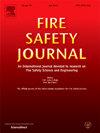The influence of forced flow on opposed flame spread
IF 3.3
3区 工程技术
Q2 ENGINEERING, CIVIL
引用次数: 0
Abstract
Opposed flow flame spread under forced flow conditions has been the subject of many studies in the flammability literature. Previous studies have presented findings such as the transition between a thermal and kinetic regime through the Damköhler number (Da). While Da scaling has been successfully used to observe the increasing influence of finite rate kinetics in the gas phase, this characterization lacks explicit measurements of the solid and gas-phase heat transfer under various flow conditions. Experiments were conducted using a range of forced flow rates (0–3 m/s) and oxygen concentrations (21–40%) to quantify the thermal conditions in the solid ahead of the flame front. Solid-phase temperature measurements provide the thermal profile, and heat transfer conditions through the solid, ahead of the flame front. These measurements are paired with CH∗ chemiluminescence measurements to explicitly define the flame structure and position relative to the fuel surface. The combination of these measurements provide novel insight into opposed flow flame spread, illustrating the increasing influence of solid-phase heat transfer at high flow rates in air (21% O2) and the increasing influence of gas-phase heat transfer in the thermal regime for oxygen rich environments (e.g., 40% O2).
强迫流动对对立火焰蔓延的影响
在强迫流动条件下的对流火焰传播一直是可燃性文献中许多研究的主题。以前的研究已经提出了一些发现,如通过Damköhler数(Da)在热态和动力学态之间的转变。虽然Da标度已经成功地用于观察气相有限速率动力学的影响,但这种表征缺乏对各种流动条件下固相和气相传热的明确测量。实验采用强制流速(0-3 m/s)和氧气浓度(21-40%)进行,以量化火焰锋面前方固体中的热状况。固相温度测量提供了热剖面和传热条件,通过固体,在火焰前面。这些测量与CH *化学发光测量配对,以明确定义火焰结构和相对于燃料表面的位置。这些测量的结合为反向流动火焰传播提供了新的见解,说明了在空气中高流速(21% O2)时固相传热的影响越来越大,以及在富氧环境(例如,40% O2)的热态中气相传热的影响越来越大。
本文章由计算机程序翻译,如有差异,请以英文原文为准。
求助全文
约1分钟内获得全文
求助全文
来源期刊

Fire Safety Journal
工程技术-材料科学:综合
CiteScore
5.70
自引率
9.70%
发文量
153
审稿时长
60 days
期刊介绍:
Fire Safety Journal is the leading publication dealing with all aspects of fire safety engineering. Its scope is purposefully wide, as it is deemed important to encourage papers from all sources within this multidisciplinary subject, thus providing a forum for its further development as a distinct engineering discipline. This is an essential step towards gaining a status equal to that enjoyed by the other engineering disciplines.
 求助内容:
求助内容: 应助结果提醒方式:
应助结果提醒方式:


